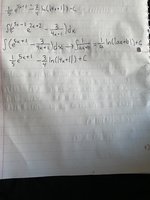MooreLikeMike
New member
- Joined
- Nov 10, 2020
- Messages
- 13
The question I'm working on ask to " Find ∫(e^(3x-1)e^(2x+2)-3/(4x+1)) dx. Find two functions g (x) and h (x) such that g' (x) = (e^(3x-1)e^(2x+2)-3/(4x+1)) = h' (x)
I found the antiderivative for the first function:1/5*e^(5x+1)-3/4*ln(abs(4x+1))+C. I just don't know how I'm supposed to find two functions from this. I thought that maybe I could write this function down twice, but change the constant "C" for both functions so that technically it would be two different functions. But I don't think that's right. I know that the function that I found can satisfy g (x) OR h (x), but not both without them being identical.
I found the antiderivative for the first function:1/5*e^(5x+1)-3/4*ln(abs(4x+1))+C. I just don't know how I'm supposed to find two functions from this. I thought that maybe I could write this function down twice, but change the constant "C" for both functions so that technically it would be two different functions. But I don't think that's right. I know that the function that I found can satisfy g (x) OR h (x), but not both without them being identical.

